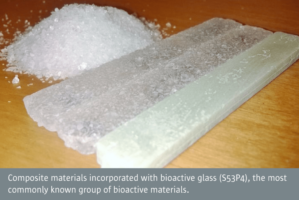In oral and orthopaedic surgery, composites can be used as implants or bone grafts. Their functions are to direct, supplement or replace living tissues. The greatest synergy of every constituent of the composite is to combine different material properties. In fact, the properties of functional composites can be customized to match those of the target tissues.
 Biostability is one of the fundamental features of dental composites. In load-bearing applications, the shape of the implant has to be preserved and the structure has to withstand the physiological stresses for several decades. However, bioactivity is a central feature of well-functioning materials. Namely, a biological interaction is important for the creation of a tight bond between hard tissue and material surface. Thus, the healing and regeneration processes are also promoted on surrounding tissues.
Biostability is one of the fundamental features of dental composites. In load-bearing applications, the shape of the implant has to be preserved and the structure has to withstand the physiological stresses for several decades. However, bioactivity is a central feature of well-functioning materials. Namely, a biological interaction is important for the creation of a tight bond between hard tissue and material surface. Thus, the healing and regeneration processes are also promoted on surrounding tissues.
Different functions in integrated composites
The research work on functional composites leads to intelligent solutions for hard-tissue repair. For instance, experimental functional composites are investigated for bone reconstruction in prosthetic applications. The goal of research on two-component or multi-component polymer composites is to combine the most favourable properties of the individual constituents. Therefore, the design and the selection of materials are essential in the development of composites for hard-tissue repair.
 The research has mainly focused on the development of fibre-reinforced and bioactive composites, where the filling components are incorporated within an inert polymer matrix, such as PMMA (polymethylmethacrylate). The following properties are required for optimal performance of the biomaterial:
The research has mainly focused on the development of fibre-reinforced and bioactive composites, where the filling components are incorporated within an inert polymer matrix, such as PMMA (polymethylmethacrylate). The following properties are required for optimal performance of the biomaterial:
- biomechanical properties matching with the target hard tissues
- multiphase polymer matrices
- biostable or partially biodegradable structures
- antibacterial effect
- bioactivity
- hierarchal composite structures
In the future, these kinds of functional composites could be employed as putty-like masses, implants or even injectable gels. For example, the applications of integrated composites could be (a) to fill large bone cavities, (b) to be used in jawbone grafting, and (c) to replace large defects in the craniofacial area.
References
Puska M, Zhang M, Matinlinna J and Vallittu P.
Silane-treated E-glass fiber-reinforced telechelic macromers based polymer-matrix composites.
Silicon, 2014, 6(1), pp. 57–63.
Hautamäki M, Puska M, Aho AJ, Kopperud H, Vallittu P.
Surface modification of fiber reinforced polymer composites and their attachment to bone simulating material.
Journal of Materials Science: Materials in Medicine, 2013;24(5):1145–1152.
Puska M, Aho A, and Vallittu P (2011).
Polymer Composites for Bone Reconstruction.
In: Advances in Composite Materials – Analysis of Natural and Man-Made Materials, p. 55–72, Tesinova P. (Ed.), ISBN: 978-953-307-449-8.
Download
NIOM Newsletter June 2014
